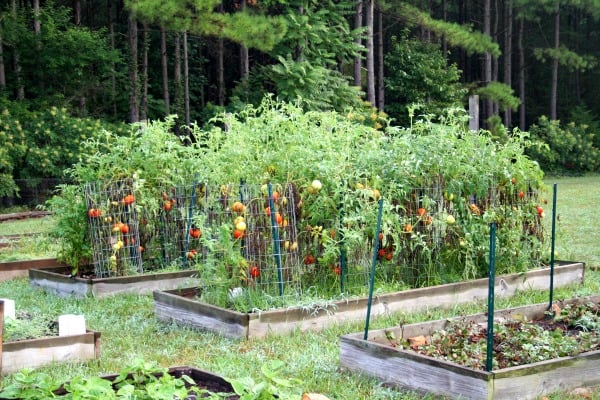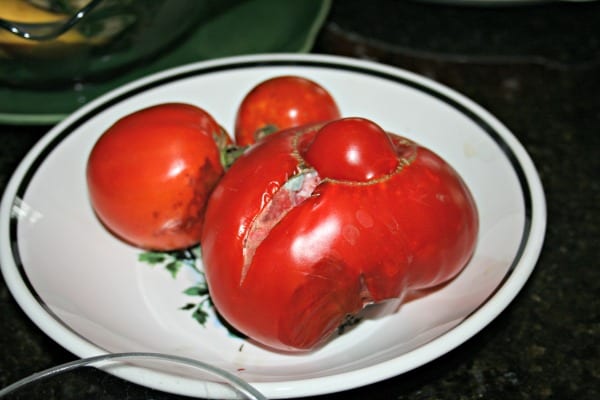Keeping birds OUT of the garden was never part of my plan. I even wrote a book about attracting birds to the garden! Yet birds are destroying my tomatoes this year…crows, to be exact. It’s fair to say I want to murder the murder of crows.
Keeping Birds Out of the Garden
I’m not sure there’s really anything that completely ‘bird proofs’ a garden. And many birds are wonderful additions to the garden. Not only do they add beautiful songs and colorful motion, some species eat insects that can damage crops. I love to see bluebirds around the garden because I know they’re dining on several species of insects that damage my plants.
But the crows…don’t get me started on the crows this year.
Here’s an example of their handiwork – or perhaps I should say beak-work?
The tomatoes look terrific this year, except for the few that the crows are destroying. That number keeps growing. Each day, there are more tomatoes pecked open and hollowed out. Most of the tomatoes they choose are ripe and cracked near the top. I think they use the crack as a wedge for their beaks to break through the skins. I’m trying to stay one step ahead of the crows and pick the tomatoes just before peak ripeness, but it’s sad to see so many of them destroyed by the crows.
In the spring, the crows love eating my strawberries. I formed an uneasy truce with them by draping a bird net over the strawberry bed from May through the end of June. After I pick enough berries to make jam, I remove the net and let them have the rest. I thought this would satisfy them, but the ripe tomatoes just a few beds over seem to their next target.

The strawberry bed (far right with posts in the corners) was draped with a bird net until July 1. The tomatoes are the new target in my raised bed garden.
Since I don’t want to shoot the birds like my farming neighbors do when they attack the corn, I started looking into other methods to deter birds, especially crows, from the garden.
Here are tips for bird proofing your garden or keeping birds out of the garden:
- Plastic nets: Yes, bird netting is still your best defense. Drape it in a tent over the affected garden beds.
- Screens: Screening or tight-weave metal mesh can be used too.
- Old CDs: This is going to be my first method of frightening the crows out of the garden – old CDs, specifically, old CD-ROM disks I had in my office that I no longer need. Drill a hole in the top, thread with fishing line or string, and hang it around the garden. The reflective light is said to frighten the birds away. You do have to move them around weekly or else the crows get used to them. Mylar streamers or reflective tape can be used in the same way.
- Cloth streamers: My neighbors tie a rope around the garden bed and tie strips of cloth to the rope. The fluttering of the cloth in the breeze scares birds awy.
- Old pie plates: Metal pie plates or tins, the kind you get with a store-bought pie, can also be cleaned up and used to scare off crows and other birds. Punch a hole in the rim, thread a string on it, and tie it to the garden fence.
Here’s what doesn’t work, according to many of the Cooperative Extension sites I went to for information: poisons, noises, scarecrows. Scarecrows generally don’t work because, like all frightening devices, they don’t move. After a while, the birds get used to them.
Crows are smart. I’ve heard they have good memories. Convincing them to leave my tomatoes alone is going to take time. My kitchen table is full of tomatoes, thank goodness, and I plan to make and can pints of salsa this weekend. But in the meantime, there are plenty more in the garden that can be made into juice for canning…if the crows leave them alone. Big “if.” We shall see if my CD method works.

Cracks like these in tomatoes are caused by sudden surges in rain. They make it easy for crows to peck open the tomato.
Resources:
- Control of Mammals and Birds in the Garden
- Humane Society
- Farm and Dairy
Let me know if you’ve found a way to successfully scare crows and other birds from the garden without using guns to shoot them, poisons, or violent methods. Thanks!








I was going to suggest you use my method of getting whole, unpecked tomatoes but you have far more plants than I do. I simply remove the tomatoes after they get the first ‘blush’ of ripening and set them in a south facing window…however, I only have four bushes. They will continue to ripen and the taste and vitamin contents don’t seem to be affected by this method. This works for me but you would run out of room in your home for the ripening tomatoes. You do have to make sure the ripening process has begun before you pick the fruit, however.
i want to know the most effective way to keep birds out without spending money.
The only way I know that is the most effective is to spend $5.99 on bird netting, which is about what they cost. I’ve tried homemade scares (cd’s hung on cords, pie tins, the works) and none of it worked. Sorry! If anyone else has any suggestions please share in the comments.